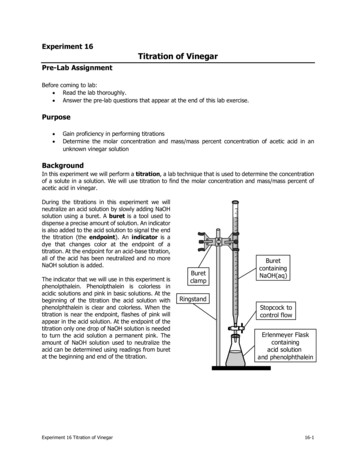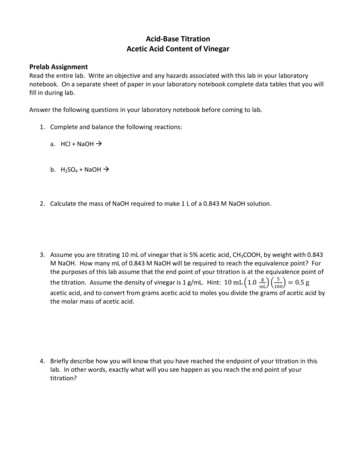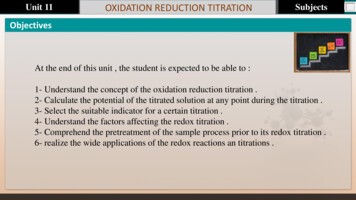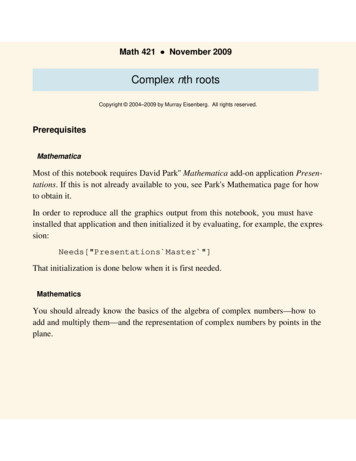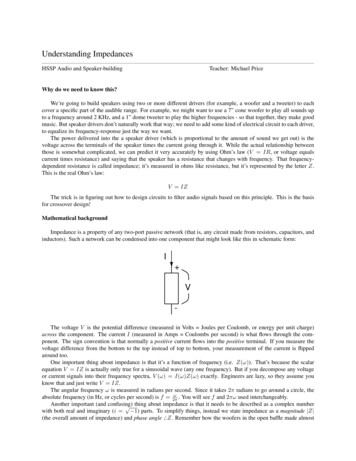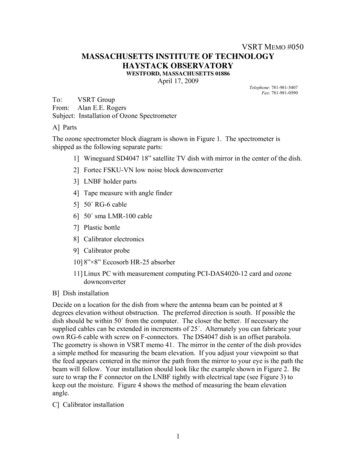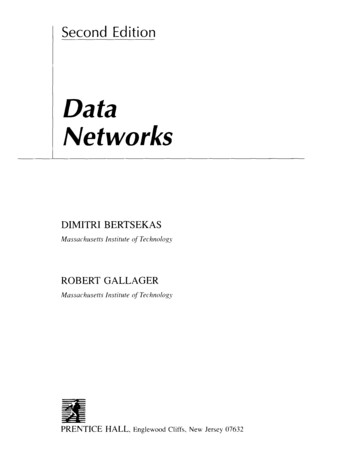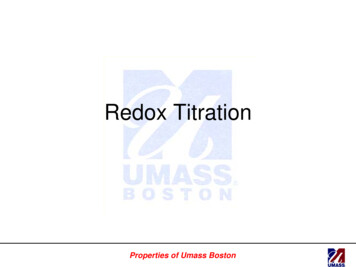
Transcription
Redox TitrationProperties of Umass Boston
Redox TitrationCe4 Fe2 Ce3 Fe3 Redox titration is basedon the redox reaction(oxidation-reduction)between analyte andtitrant.Properties of Umass Boston
Position of the end pointProperties of Umass Boston
Determine the end point Indicator electrode Redox indicators – the indicator hasdifferent color at reduction and oxidationstate. Non redox indicator – change color whenexcess amount of titrant exists, e.g.Starch changes to deep blue color whenexcess amount I2 remainsProperties of Umass Boston
Redox indicatorProperties of Umass Boston
Redox indicatorsThe indicator potential transition range should overlapthe steep part of the titration curveProperties of Umass Boston
Adjustment of oxidation state Sometimes the oxidation states ofanalytes need to be adjusted beforetitration – oxidants need to be removed.– Pre-oxidation: S2O8 2- (peroxydisulfate, persulfate):S2O82- 2e 2SO42S2O82- 2H2O 4SO42- O2 4H (boiling)sometime, Ag is needed as catalystS2O82- Ag SO42- SO4- 4Ag2 H2O2Properties of Umass Boston
Adjustment of oxidation state– Pre-reduction SnCl2, etc Reductor:Jones reductor: Zn-Zn amalgamWalden reductor: Ag/AgClProperties of Umass Boston
Example of typical oxidants Potassium Permanganate (KMnO4)MnO4- 8H 5e Mn2 4H2O Eo 1.507V (pH 1)MnO4- 4H 3e MnO2 (s) 2H2O Eo 1.692V (pH 7)In alkaline solution: MnO4- e MnO42 Preparation, standardization and storage– Not a primary standard, MnO2 impurity– To prepare, dissolve KMnO4 in DI water, boil in a hourto make sure oxidize all organics, filter throughsintered glass filter (why?), store in dark glass.– Use either Fe2 or sodium oxalate (Na2C2O4) forstandardizationProperties of Umass Boston
Properties of Umass Boston
Methods involving Iodine Iodine is hardly soluble in water, but very soluble in IodidesolutionI2 I- I3- (triiodide) Iodimetry: I3- as titrantIodometry: I3- is produced by adding oxidating analytes intoexcess amount of Iodide (I-) Indicator starch, added near the end point (Iodometry), butat the beginning for Iodimetry. Standardization (pure enough for primary standard, butevaporates during weighting)– Weight and dissolve in I– Use Arsenious Oxide (As4O6) or Soduim Thiosulfate (Na2S2O4) forstandardization Storage, no light, no oxygenProperties of Umass Boston
Properties of Umass Boston
Properties of Umass Boston
Can be used to analyze oxidantsand reductantsProperties of Umass Boston
ElectroanalysisProperties of Umass Boston
Thermodynamic and Kinetic If there is no net current passing through theelectrochemical cell, the system is atthermodynamically equilibrium state. Thepotential can be calculated by Nernst equation. If there is net current passing through, thesystem is away from the thermodynamicequilibrium state, thus the potential can not becalculated by Nernst equationProperties of Umass Boston
Kinetics of electrochemical system When Current passingthrough the system, thepotential will move away fromthat of equilibrium state forthree reasons– Overpotential– IR drop– Concentration polarizationProperties of Umass Boston
Overpotential Overpotential is to overcome the activationof energy barrier of the reactionProperties of Umass Boston
IR drop Inevitably, the electrochemical systemwill have ohimic resistance, when thecurrent runs through the system, thevoltage will drop due the ohmicresistance: V IRProperties of Umass Boston
Concentration Overpotential Due to the concentration gradient fromthe surface of the electrode to the bulk ofthe solution.Properties of Umass Boston
Three electrode system Working electrode:where the analyticalreaction happens Counter electrode: forthe current to flow andmake a close circuit. Reference electrode:no current pass throughand serve as areference point forpotential measurement Why three electrodesystem is needed?Properties of Umass Boston
Amperometry Diffusion limitedcurrentProperties of Umass Boston
Three electrode system Working electrode:where the analyticalreaction happens Counter electrode: forthe current to flow andmake a close circuit. Reference electrode:no current pass throughand serve as areference point forpotential measurement Why three electrodesystem is needed?Properties of Umass Boston
Polarography: Historical Significance Polarograph developed by JaroslavHeyrovsky in 1922. Heyrovsky won Nobel Prize Polarograph is THE most widely usedelectro analytical method Still one of the most reliable analyticalmethod for ppm level impurities.Properties of Umass Boston
Setup Polarograph Dropping Hgelectrode (DME) Working underlimited diffusioncurrentProperties of Umass Boston
Polarography curveProperties of Umass Boston
Example Cd2 2e CdZn2 2e ZnE (vs SCE) -0.64 VE (vs SCE) -1.10 VProperties of Umass Boston
Electrogravimetric Analysis Quantitatively electrochemicallydeposit analyte onto electrode,the amount of analyte can bemeasured by measure the weightchange of the electrode. The end point determination– Color change e.g.Cu2 2e Cu– Deposition on fresh electrodesurface.Properties of Umass Boston
Electrogravimetric Analysis Current-Voltage relationship Interference of other ions To limit the potential,depolarizer is added to preventhydrogen or oxygen evolution.e.g.NO3- 10H 8e NH4 3H2OPrevent hydrogen evolutionProperties of Umass Boston
Coulometry Generating titrateelectrochemically, the amount oftitrate generated can bemeasured by counting electrons. Detector anode2Br- Br2 2e Detector cathodeBr2 2e Br-Properties of Umass Boston
Coulometry Advantage of Coulometry titration– Precision– Sensitivity– Generating otherwise unstable titrant in-site Constant current Q I x t Constant potential– 3-electrode system– Q I x t– More sensitive and selectiveProperties of Umass Boston
Cyclic voltammetry Linear Sweep Voltammetry (LSV) Cyclic Voltammetry (CV)-good for the study of reactionmechanism– Initial potential– End potential– Sweep rate (mV/s)Properties of Umass Boston
Karl Fischer Titration of H2O Detectingtrace amountof water inorganicsolution. An example ofcoulometrictitrationProperties of Umass Boston
Adjustment of oxidation state Sometimes the oxidation states of analytes need to be adjusted before titration – oxidants need to be removed. – Pre-oxidation: S. 2. O. 8 2-(peroxydisulfate, persulfate): S. 2. O. 8 2- 2e 2SO. 4 2-S. 2. O. 8 2-2 2H. 2. O 4SO. 4 - O. 2 4H (boiling) sometime, Ag is needed as catalyst 2 S. 2. O. 8 2- Ag 2 SO. 4- SO. 4- 4Ag H. 2. O. 2
